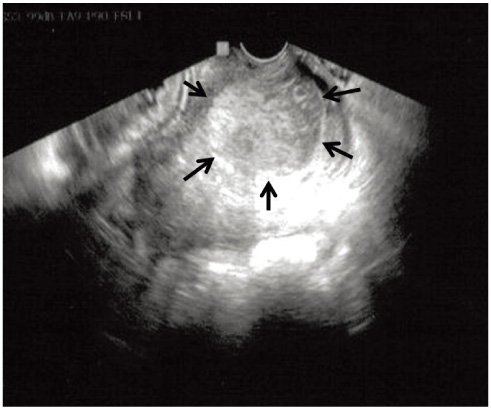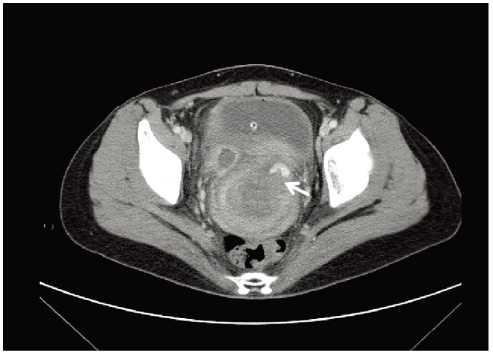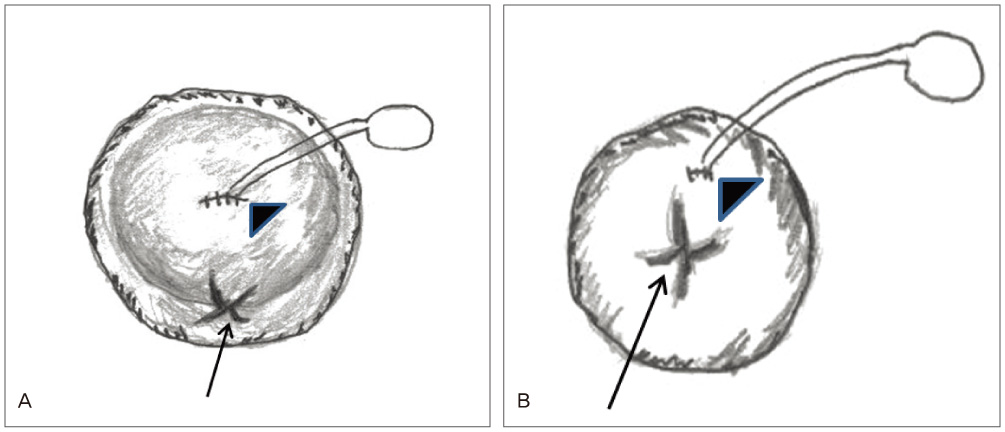Korean J Obstet Gynecol.
2012 Feb;55(2):137-141. 10.5468/KJOG.2012.55.2.137.
A case of treatment by embolization of uterine arterial pseudoaneurysm following laparoscopic supracervical hysterectomy
- Affiliations
-
- 1Department of Obstetrics and Gynecology, Soonchunhyang University Chunan Hospital, University of Soonchunhyang College of Medicine, Chunan, Korea. drsook@schmc.ac.kr
- 2Department of Interventional Radiology, Soonchunhyang University Chunan Hospital, University of Soonchunhyang College of Medicine, Chunan, Korea.
- KMID: 2078129
- DOI: http://doi.org/10.5468/KJOG.2012.55.2.137
Abstract
- Laparoscopic supracervical hysterectomy is relatively new and minimally invasive surgery. The advantages of this operation are conserving the cervix. But it has complications like intraoperative bleeding, ureteral injury, bowel perforation and postoperative hematoma. Pseudoaneurysm can be acquired in association with trauma, previous surgery, trophoblastic disease. When a punctured artery does not seal completely, blood may escape and dissects the adjacent tissues, and collects in perivascular areas. If this maintains in communication with the parent vessel, a pseudoaneurysm could result. Typically the lesions are discovered because the patients have symptoms related to delayed rupture of the pseudoaneurysm, causing severe hemorrhage. Radiologic techniques have provided the opportunity to diagnose and treat pseudoaneurysm. We experienced a case of severe hemorrhage in the cervix four weeks following laparoscopic supracervical hysterectomy attributed to a pseudoaneurysm of the uterine artery and treated with arterial embolization.
MeSH Terms
Figure
Reference
-
1. Nam AN, Cho SH, Seo KS, Jeon YE, Kim HY, Choi YS. Laparoscopic total hysterectomy versus laparoscopic supracervical hysterectomy: the effect on female sexuality. J Womens Med. 2008. 1:43–47.2. Washington JL. Laparoscopic supracervical hysterectomy compared with abdominal, vaginal, and laparoscopic vaginal hysterectomy in a primary care hospital setting. JSLS. 2005. 9:292–297.3. Jin K. Comparative study of laparoscopic assisted vaginal hysterectomy and laparoscopic supracervical hysterectomy. Korean J Obstet Gynecol. 2010. 53:1118–1123.4. Lee JW, Kim HC, Chang SW, Kang SH, O YR, Seok HH, et al. Cases of transarterial embolization in arteriovenous malformation of uterus. Korean J Obstet Gynecol. 2005. 48:2468–2473.5. Kim MJ, Park CH, Kwen I, Lee HJ, Hur SY, Kim EJ, et al. An uncommon cause of postpartum hemorrhage after cesarean section treated with selective arterial embolization: pseudoaneurysm of the uterine pedicle. Korean J Obstet Gynecol. 2004. 47:2236–2240.6. Hoffman MK, Meilstrup JW, Shackelford DP, Kaminski PF. Arteriovenous malformations of the uterus: an uncommon cause of vaginal bleeding. Obstet Gynecol Surv. 1997. 52:736–740.7. Kwon JH, Kim GS. Obstetric iatrogenic arterial injuries of the uterus: diagnosis with US and treatment with transcatheter arterial embolization. Radiographics. 2002. 22:35–46.8. Reich H, DeCaprio J, McGlynn F. Laparoscopic hysterectomy. J Gynecol Surg. 1989. 5:213–216.9. Liu CY. Laparoscopic hysterectomy. A review of 72 cases. J Reprod Med. 1992. 37:351–354.10. Lyons T. Laparoscopic supracervical versus total hysterectomy. J Minim Invasive Gynecol. 2007. 14:275–277.11. Lyons TL. Laparoscopic supracervical hysterectomy. Obstet Gynecol Clin North Am. 2000. 27:441–450.12. van Evert JS, Smeenk JM, Dijkhuizen FP, de Kruif JH, Kluivers KB. Laparoscopic subtotal hysterectomy versus laparoscopic total hysterectomy: a decade of experience. Gynecol Surg. 2010. 7:9–12.13. Shin WK, Kim DJ, Kim HM, Park SH, Jun HA, Lee KY. A case of angiography and transarterial embolization in arteriovenous malformation of uterus after a cesarean section episode. Korean J Obstet Gynecol. 2007. 50:801–806.14. Mitchell DG, Needleman L, Bezzi M, Goldberg BB, Kurtz AB, Pennell RG, et al. Femoral artery pseudoaneurysm: diagnosis with conventional duplex and color Doppler US. Radiology. 1987. 165:687–690.15. Zimon AE, Hwang JK, Principe DL, Bahado-Singh RO. Pseudoaneurysm of the uterine artery. Obstet Gynecol. 1999. 94:827–830.
- Full Text Links
- Actions
-
Cited
- CITED
-
- Close
- Share
- Similar articles
-
- Pseudoaneurysm of uterine artery causing intra-abdominal and vaginal bleeding after cervical conization
- Comparative study of laparoscopic assisted vaginal hysterectomy and laparoscopic supracervical hysterectomy
- Update in Laparoscopic Hysterectomy and Laparoscopic Myomectomy
- Incidence of cyclical bleeding after laparoscopic supracervical hysterectomy
- Failed two cases' analysis of eight Transarterial embolization therapy for Pseudoaneurysm followed by D&C





